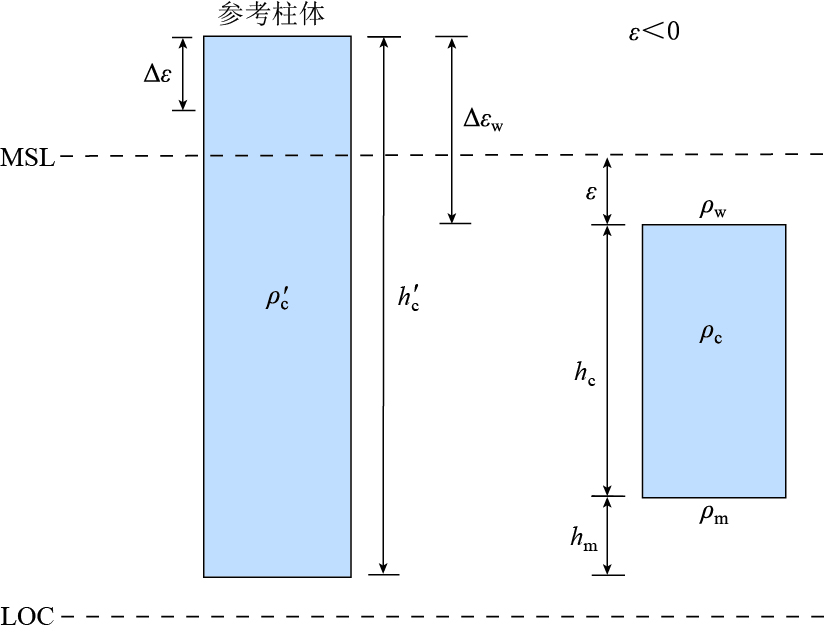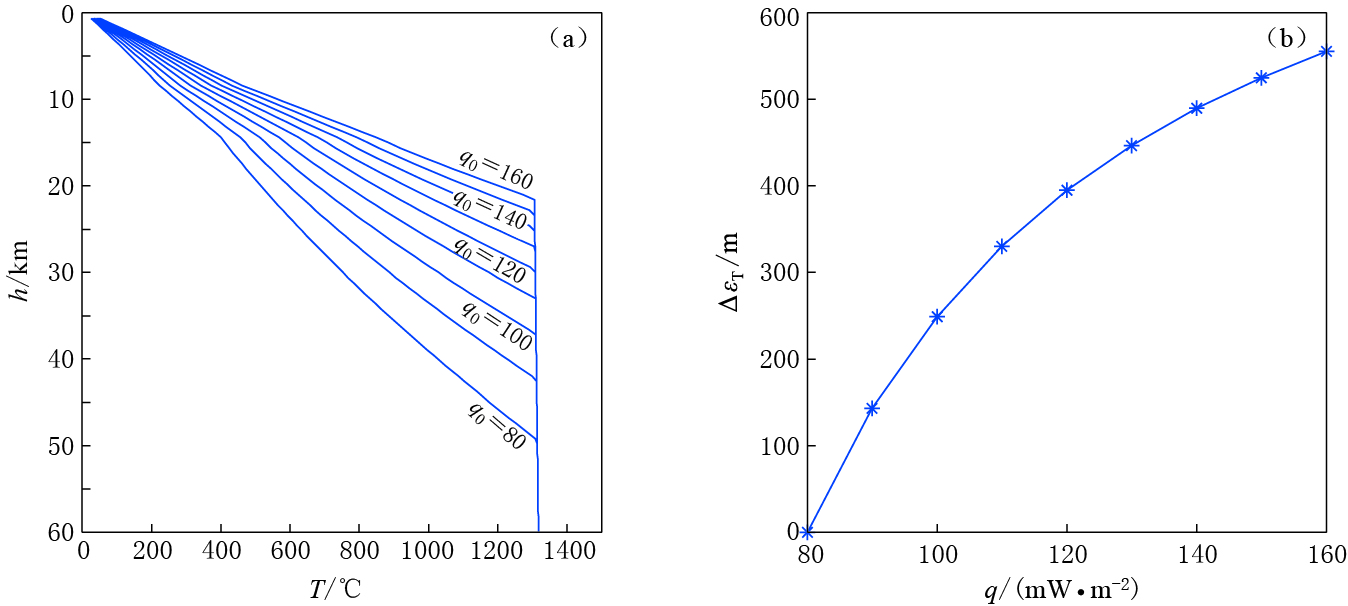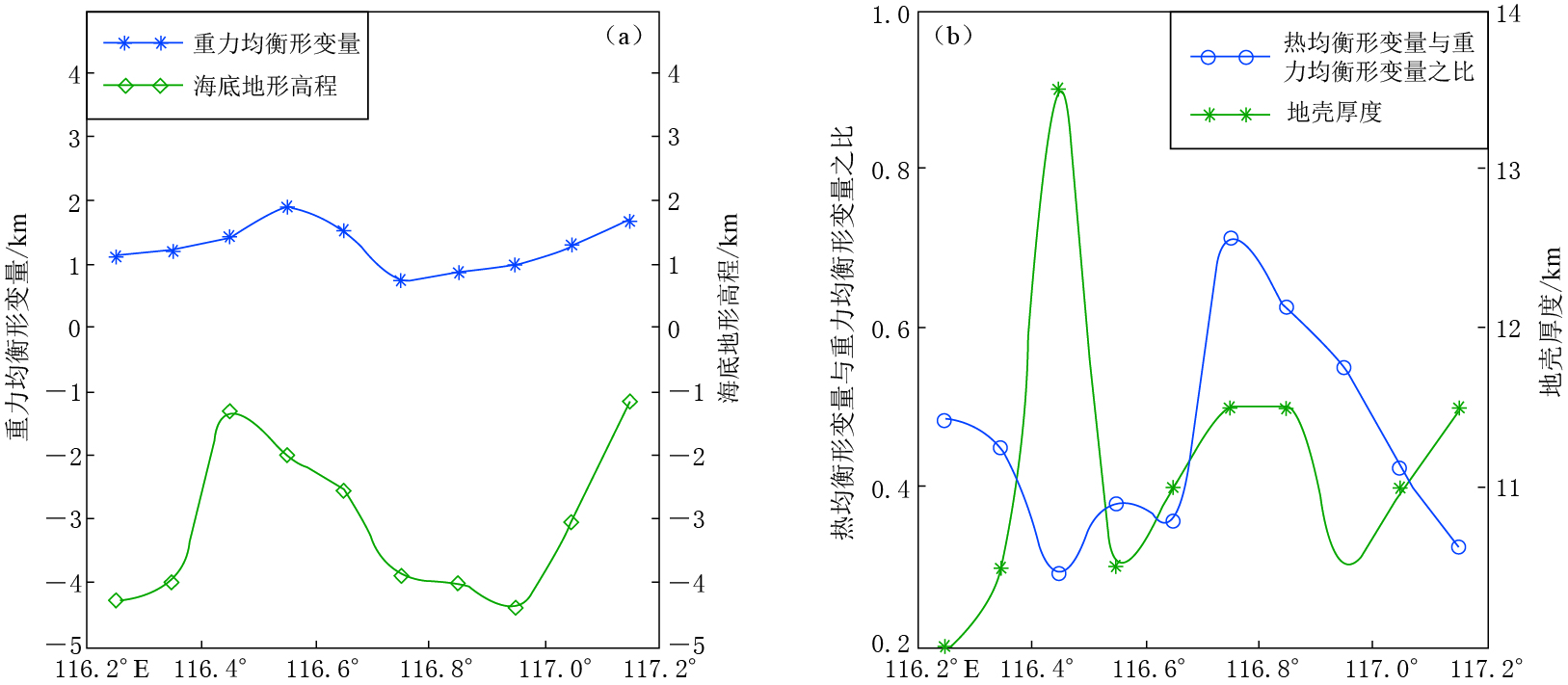Thermal-gravity equilibrium adjustment mechanism of Zhenbei-Huangyan seamount chain
-
摘要: 珍贝—黄岩海山链作为我国南海的残留扩张中心, 对其研究具有重要的科学意义. 本文运用均衡学方法, 通过重力异常数据反演了过珍贝—黄岩海山链剖面的地壳界面变化, 同时计算了岩石圈热结构状态, 在此基础上建立了珍贝—黄岩海山链的岩石圈地温结构模型. 通过均衡分析方法, 对剖面上测点的海底地形数据进行了热均衡和重力均衡分析, 得到了热均衡和重力均衡形变量. 结果表明, 在珍贝—黄岩海山链高热流区域, 热均衡作用可以产生最大约0.55 km的形变, 其重力均衡形变范围为0.77—1.89 km. 热均衡通过改变海底地形和地壳物质密度不断作用于重力均衡, 重力又反过来作用于热均衡, 形成了热均衡-重力均衡动态调节机制.Abstract: During the processing of isostatic gravity anomaly analysis, it was pointed that the isostatic correction of the South China Sea was not completely, especially in Zhenbei-Huangyan seamount chain. No reasonable explanation for this phenomenon has been proposed until now, and seamounts compensation mechanism remains unresolved. It is feasible and necessary to conduct the dynamic equilibrium research in this region. We combine the thermal and gravimetric method to evaluate crustal density structure so as to establish the litho-spheric thermal structure of Zhenbei-Huangyan seamount chain based on the observed free-air gravity anomaly data. And then we analyze the thermal equilibrium and the gravity equilibrium effects based on the submarine topography data by adopting the standardized equilibrium technology. The results show that in the high heat flow region of Zhenbei-Huangyan seamount chain, the deformation induced by the thermal equilibrium is up to 0.55 km and the deformation due to the gravity is from 0.77 to 1.89 km. As a long-term adjustment factor, the thermal equilibrium constantly affects the gravity equilibrium by changing submarine topography and crustal material density, and gravity acts on geothermal equilibrium in turn at the same time, so the dynamic adjustment mechanism generates.
-
-
图 1 研究区地质与地球物理特征图
(a) 南海海底地形及热流q (单位: mW/m2)测点图, 黑色框为本文研究区域; (b) 珍贝—黄岩海 山链海底地形图, 图中AB为过珍贝—黄岩海山链的地震剖面; (c) 珍贝—黄岩海山链 自由空间重力异常图; (d) 珍贝—黄岩海山链布格重力异常图
Figure 1. Geological and geophysical characteristics of the research areas
(a) Bathymetric chart and heat-flow q (in unit of mW/m2) observation point distribution, the black rectangle gives the studied area in this study; (b) Topography of the Zhenbei-Huangyan seamount chain, where AB is a seismic profile across Zhenbei-Huangyan seamount chain; (c) The free air gravity anomaly of the Zhenbei-Huangyan seamount chain; (d) The Bouguer gravity anomaly of the Zhenbei-Huangyan seamount chain
图 2 海洋地壳组分均衡调整模式示意图(引自McKenzie等, 2005)
图中LOC为补偿深度, MSL为平均海平面
Figure 2. Schematic diagram of parameters used in gravitational correction of the ocean area (after McKenzie et al, 2005)
LOC is the compensation depth, MSL is the mean sea level
图 3 热均衡计算结果
(a) 给定地表热流值情况下岩石圈热结构图; (b) 热均衡产生的垂直形变量ΔεT随地表热流值q变化图
Figure 3. The computing result of the thermal equilibrium
(a) Theory thermal structure of the lithosphere on the condition that a surface heat flow value is given; (b) Variation of vertical deformation ΔεT caused by thermal equilibrium with surface heat flow q
图 4 过珍贝—黄岩海山链的三维地震速度剖面[根据丘学林等(2012)和王建等(2014)修改]
Figure 4. D seismic section across Zhenbei-Huangyan seamount chain modified from Qiu et al (2012) and Wang et al (2014)
图 5 重力均衡计算结果
(a) 重力均衡形变量与海底地形高程对比图; (b) 热均衡形变量与重力均衡形变量之比与地壳厚度对比图
Figure 5. The computing result of the gravity equlibrium
(a) Comparison between vertical deformation caused by gravity equlibrium (blue line) and the seabed terrain elevation (green line); (b) Comparison between the ratio of thermal equlibrium to gravity equlibrium (blue line) and crustal thickness (green line)
表 1 热均衡模型的材料参数(引自张健和石耀霖, 2004)
Table 1 Material parameters of the thermal equilibrium model (after Zhang and Shi, 2004)
分层 生热率A/(μW·m-3) 比热容c/(J·(kg·℃)-1) 热导率k/(W·(m·℃)-1) 大洋沉积层 1.280 900 0.85 洋壳层2 1.300 900 2.93 洋壳层3 0.400 900 2.30 岩石圈上地幔 0.024 1000 3.30 表 2 过珍贝—黄岩海山链的地震剖面上各观测点参数
Table 2 Model parameters of the observation points on the seicmic section across Zhenbei Huangyan seamount chain
测点 海底地形高程/km 地壳厚度/km 平均地壳密度/(g·cm-3) 2 -4.28 10 2.731 3 -4.01 10.5 2.754 4 -1.31 13.5 2.703 5 -2.00 10.5 2.766 6 -2.55 11 2.734 7 -3.88 11.5 2.718 8 -4.01 11.5 2.697 9 -4.39 10.5 2.723 10 -3.06 11 2.710 11 -1.15 11.5 2.676 -
张训华. 1996. 地壳均衡与均衡重力异常[J]. 海洋地质动态, (8): 1-4. Zhang X H. 1996. The isostasy and isostatic gravity anomaly[J]. Marine Geology Letters, (8): 1-4 (in Chinese).
Taylor B, Hayes D E. 1980. The tectonic evolution of the South China Sea basin[G]//The Tectonic and Geologic Evolution of Southeast Asian Seas and Islands. New York: American Geophysical Union: 89-104.
Taylor B, Hayes D E. 1983. Origin and history of the South China Sea basin[G]//The Tectonic and Geologic Evolution of Southeast Asian Seas and Islands. New York: American Geophysical Union: 23-56.
Turcotte D L, Schubert G. 2002. Geodynamics[M]. 2nd ed. Cambridge: Cambridge University Press: 1-456.
-
期刊类型引用(5)
1. 尹晶飞,汪贞杰,江聪杰. 台风“利奇马”对钻孔体应变的扰动分析——以浙江地区为例. 地震地磁观测与研究. 2022(04): 95-105 .  百度学术
百度学术
2. 袁媛,韩娜娜. 西太平洋台风对上海地区钻孔应变的低频扰动特征分析. 地震工程学报. 2021(01): 33-42 .  百度学术
百度学术
3. 史小平,张磊,姜振海. 临夏台分量钻孔应变观测与岷县—漳县6.6级地震的相关性分析. 地震工程学报. 2020(02): 391-395 .  百度学术
百度学术
4. 邱泽华,唐磊,郭燕平,张宝红. 姑咱台的十年钻孔应变观测和汶川地震前兆异常. 地球物理学进展. 2020(04): 1299-1309 .  百度学术
百度学术
5. 杨小林,杨锦玲,危自根. 中国东南沿海地区钻孔体应变对超强台风“利奇马”的响应特征与机制. 地震学报. 2020(03): 306-318 .  本站查看
本站查看
其他类型引用(0)





 下载:
下载:




